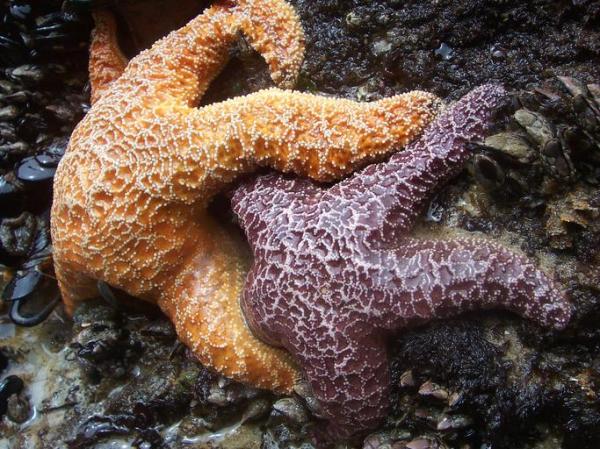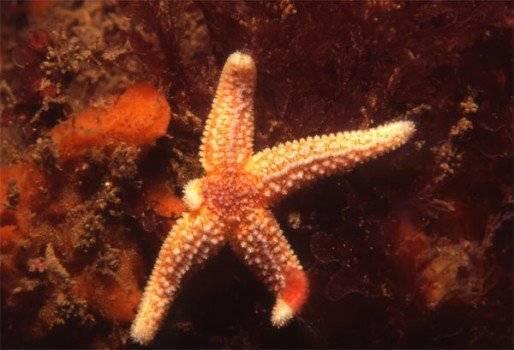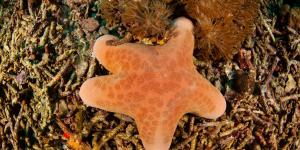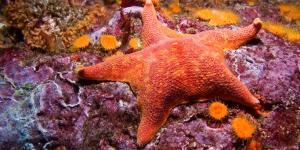How Do Starfish Reproduce?


Starfish are marine echinoderms with habits that are uncommon in most other animal species. One fascinating example is the ability of sea stars to grow new limbs if they are severed from the body. Some species can even grow entirely new organisms from the severed arm, but only in the right circumstances. This is a type of starfish reproduction, of which there are others. This is because starfish can reproduce both sexually and asexually. They can breed new starfish both with others and on their own.
AnimalWised explains the processes of sexual and asexual starfish reproduction by asking how do starfish reproduce? We not only explain how sea stars can reproduce in this way, but we explain why.
About starfish reproduction
Starfish make up the class of echinoderms known as Asteroidea. They are marine invertebrates with habitats ranging from the intertidal zone down to the abyssal depths of 6,000m and below. They normally have a central disc and five arms, giving them their infamous star shape. Despite sharing fundamental characteristics, there are 2,000 known species of starfish. They can vary greatly in habitat, size, color and habits.
The average lifespan of a starfish is 35 years. These sea stars are mainly carnivores that feed on coral, sponges, clams, oysters, sand dollars and mussels. They do this by first extending a stomach out of their mouth to cover the digestible parts of their prey. The prey's tissue is partially digested externally before the soup-like ‘chowder’ produced is drawn back into the starfish's 10 digestive glands. Learn more in our article about what starfish eat.
And so, you see, although these sea creatures are beautiful and seem to merely be resting on a rock or the sand, there's actually a lot more to their existence and survival. One of their many mysteries concerns how starfish reproduce.
Although starfish are not actually a type of fish, you can learn about the fish that can live in very deep oceans with our article explaining the different types of abyssal fish.
Are starfish oviparous or viviparous?
As with all animals, starfish have egg cells (oocytes) which give rise to a new organism. Most starfish are oviparous. From the union of released sperm and eggs, a large number of zygotes are formed. They are usually deposited on the seabed.
In a minority of species, they can be laid in incubator structures on the body of their parents. When they hatch, they are not the star shapes we are all familiar with, but planktonic larvae that drift around. This is a process known as brooding which can help increase survival rates by providing greater protection for the young.
Starfish larvae are bilateral, i.e. their bodies are divided into two equal parts. Their function is to disperse throughout the ocean, colonizing new places. As they do so, they feed and grow until it is time for them to become adults. To do this, they descend to the bottom of the sea and undergo a process of metamorphosis.
Although it is very rare, we should mention that some species are viviparous. This is when the embryos are developed completely inside the parent and are alive when birthed. These young may derived some of their nutrients from their parents.
This is the case of Tasmanian live-bearing seastar (Parvulastra vivipara) whose offspring develop inside the gonads of their parents. When they become independent of them, they already have pentamerous symmetry (five arms) and live at the bottom of the sea.
How starfish reproduce sexually
The reproduction of starfish begins when the right environmental conditions exist. Most of them reproduce during the warmer season. Many also choose the days of high tide. They spawn in order to fertilize the gametes. This means they mate by releasing their sex cells into the water.
Starfish do this by gathering in groups called “spawning aggregations”. This increases the likelihood that the sperm and egg will find each other. Starfish have sexual organs, also called gonads, on each of their arms. It's important to mention that mating strategies can slightly vary from species to species.
Once in their spawning aggregation, starfish interlock their arms. This causes the synchronized release of gametes by both sexes, females release their eggs and males their sperm. This is how external fertilization occurs, the beginning of the life cycle of a starfish. This type of mating is called pseudocopulation, since there is physical contact but no penetration.
There is no pregnancy, embryos are formed and developed in the water. In some species they will form and develop on the body of the parents. Therefore, most starfish are oviparous, as the embryos is formed and developed externally. However, there are certain species of starfish, like the Tasmanian live-bearing seastar (Parvulastra vivipara), that are viviparous as their young develop within the gonads of their parents. They become fully independent and leave their parents once they have fully developed their 5 arms.
In some species, such as the sand star (Archaster typicus), pseudocopulation is done in pairs. A male stands on top of a female, interspersing his arms. Viewed from above, they look like a single ten-pointed star. They can stay like this for a whole day, so much so that, many times, they are covered by sand. Lastly, as in the previous case, both release their gametes and external fertilization occurs.
In the latter case, although the mating is done in pairs, they are also added in groups. That way, they increase their chances of reproducing, as well as having several offspring throughout the same reproductive season. Therefore, starfish are clearly polygamous animals.
You may also be interested in our article about the endangered animals of the great barrier reef.

How starfish reproduce asexually
Starfish can also reproduce without mating. So, how can starfish reproduce asexually? Well, starfish have the ability to regenerate lost arms. When an arm is damaged in an accident, it can be dislodged. They also do it, for example, when they are chased by a predator with the aim of entertaining them while they escape. Later, they begin to re-form the lost arm. However, this is a very expensive process that can take several months.
Some species can regenerate their entire body from a detached arm. Although they can only do this if they keep at least 1/5 of their central disk. As we've previously mentioned, starfish's body is divided into five equal parts. Therefore, not only do they have five arms, but their central disc is also pentameric. When the necessary conditions are met, this central disk breaks or splits into two or more parts (up to five), each with its corresponding arm.
Therefore, if a starfish detaches 1/5 of their arm and central disk, they will reproduce themselves. This means that the new individual will be identical to their progenitor. This type of asexual reproduction has been found in many individuals of the Aquilonastra corallicola starfish species.
You may also be interested in our article about on animals without a brain.

If you want to read similar articles to How Do Starfish Reproduce?, we recommend you visit our Facts about the animal kingdom category.
- Hickman, CP et al (2009). Comprehensive Principles of Zoology . McGraw-Hill, Madrid.
- Rivadeneira, PR, Martinez, MI, Penchaszadeh, PE, & Brogger, MI (2020). Reproduction and description of a new genus and species of deep-sea asteriid sea star (Echinodermata; Asteroidea) from the southwestern Atlantic . Deep Sea Research Part I: Oceanographic Research Papers, 163, 103348.
- Motti, CA, Bose, U., Roberts, RE, McDougall, C., Smith, MK, Hall, MR, & Cummins, SF (2018). Chemical ecology of chemosensation in Asteroidea: insights towards management strategies of pest species . Journal of chemical ecology, 44 (2), 147-177.
- Keesing, JK, Graham, F., Irvine, TR, & Crossing, R. (2011). Synchronous aggregated pseudo-copulation of the sea star Archaster angulatus Müller & Troschel, 1842 (Echinodermata: Asteroidea) and its reproductive cycle in south-western Australia . Marine Biology, 158 (5), 1163-1173.
- Byrne, M. (1996). Viviparity and intragonadal cannibalism in the diminutive sea stars Patiriella vivipara and P. parvivipara (family Asterinidae) . Marine Biology, 125 (3), 551-567.
- Lawrence, JM, & Gaymer, CF (2012). Autotomy of rays of Heliaster helianthus (Asteroidea: Echinodermata) . Zoosymposia, 7 (1), 173-176.
- Sterling, KA, & Shuster, SM (2011). Rates of fission in Aquilonastra corallicola Marsh (Echinodermata: Asteroidea) as affected by population density . Invertebrate Reproduction & Development, 55 (1), 1-5.






 Great job and very informative. Just one correction… Please stop calling a sea star a star fish… Thanks for doing your best to educate the adults of tomorrow. Keep up the great job
Great job and very informative. Just one correction… Please stop calling a sea star a star fish… Thanks for doing your best to educate the adults of tomorrow. Keep up the great job



